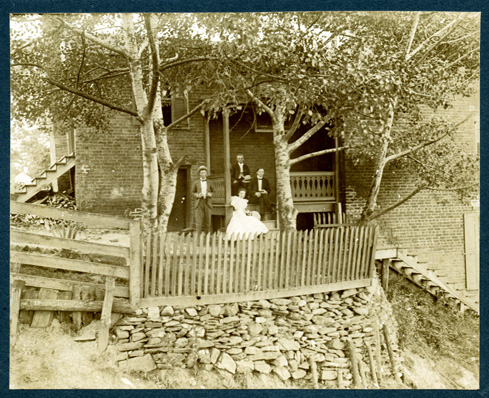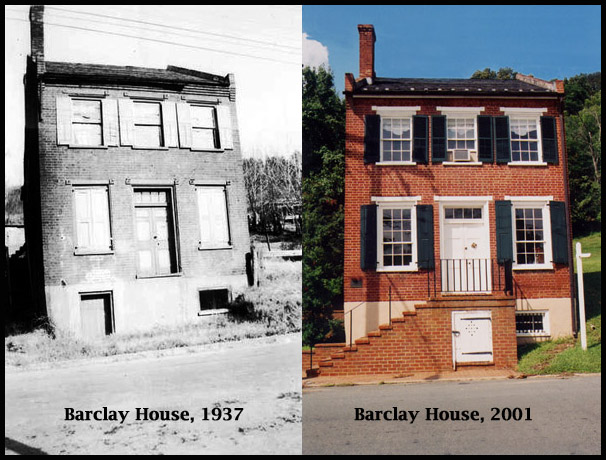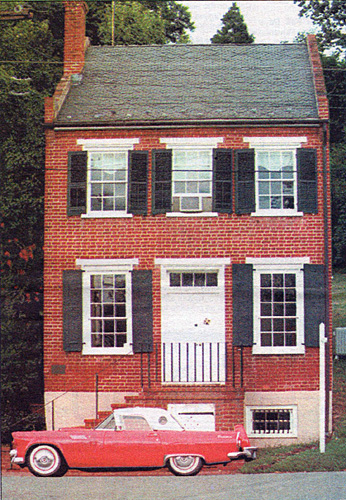

  |
|

|
Name: Barclay House Date: ca. 1900 Image Number: B02cdB19 Comments: The Barclay House is a small townhouse on Scottsville's Lot 31 and is next door to the Disciples of Christ Church (now Scottsville Museum) on Main Street. John B. Hart purchased this property without a structure in 1830 and resold the lot six months later for his original purchase price. On January 1, 1838, Daniel P. Perkins sold Lot 31 with its 'house and lot on Main Street' to Sarah C. Harris, mother of James Turner Barclay. By 1850, Dr. James Turner Barclay and his family lived in this house next door to the Disciples of Christ Church where he was its first minister. The house's side entrance, shown here in this photo, was the front door to the Barclay's home. In 1851, Dr. Barclay went to Jerusalem as his Church's first missionary, and turned over his Main Street home to Thomas Staples, an Elder in the Disciples of Christ Church. Later Elizabeth Staples Davis lived here with her family, who are shown sitting on the Barclay steps in this 1900-vintage photo. Today the Barclay House serves as Scottsville Museum's historical and genealogical resource center. Shown below are photos to compare how the Barclay House looked in 1937 and how it looked in 2001. The 1937 photo is part of the Historical Inventory Report by R.E. Hannum for the Works Progress Administration of Virginia; Record No. VHIR/02/0282 applies at the Library of Virginia, Richmond, Virginia.  To learn more about how ownership of the Barclay House was passed to Scottsville Museum in 1970 by the Perry Foundation, please read the following article that appeared in the Daily Progress on September 06, 1970: Scottsville House Given to Museum Daily Progress, September 06, 1970 The Scottsville Museum last week received the adjoining Barclay House as a gift of the Perry Foundation. According to Miss Virginia Moore, a Scottsville author and historian, the Perry Foundation of Charlottesville purchased the house for the museum last week. The Foundation is holding the title until the museum committee is incorporated and legally able to receive it. Miss Moore noted, however, that John Wise of the Perry Foundation told her the museum can already consider the property its own as a gift, until the incorporation is effected. The house was the home of Dr. James R. Barclay, a founder of the Disciples' Church, which is now the Scottsville Museum. Barclay donated the land adjoining his house for the church which was built in the mid-19th century. Miss Moore said that if the adjoining Barclay house were not owned by the museum, and if it were used commercially, it would distract from the museum. Another party, reported to be an Albemarle County contractor, was interested in the building and was supposed to have been near closing on the property when the Perry Foundation was contacted by Miss Moore on behalf of the museum committee. "We hope to landscape the lot and make a beautiful complex out of it," Miss Moore said. To meet Perry Foundation requirements, Miss Moore said she drafted an extensive letter to outline the museum's request and its reasons for wanting the property. While waiting for the reply of the foundation's board of directors, Miss Moore said those close to the museum experience "a very tense few days." The board agreed through unanimous decision to present the building to the museum. Miss Moore praised the influence of Francis Duke, whose writings in a recent issue of the Albemarle Civil League bulletin outlined the need to preserve historic buildings in Scottsville. Scottsville Mayor Raymon Thacker expressed excitement at the news of the foundation's action and a hope that more of the town's old structures can be restored and preserved. According to Miss Moore, the museum committee hopes to completely restore the Barclay house. Plans are already formulated to add lateral steps in the front of the building. She said the museum and Barclay house should be considered an asset to all of Albemarle County, not just the town of Scottsville. The Barclay house was constructed prior to the museum building, which was built in 1846. In 2000, heavy rains came, and water and mold damaged the Barclay House. The Scottsville Museum undertook the repair and renovation of this historic building to prepare it for use as the Museum's resource center for genealogy and area historical research. To learn more, please read the following article by Laurel Greene, which appeared in The Rural Virginian on August 08, 2001: In Scottsville: Barclay House Being Renovated
By Laurel Greene, The Rural Virginian, August 08, 2001  Restoration of shutters and stoop made a difference in this 2001 photo of the Barclay House compared to the 1937 photo of it at left above. "The present is a fine line between the past and the future." Too often too many people try to walk that fine line Fortunately Scottsville has a number of folks with two-way vision - past and future. One of those people is Gwynne Daye, current president of the Scottsville Historical Museum. Daye has a passion for the museum, and particularly for its current big project, renovation of the Barclay House. The Barclay House, which correctly should be called the Hart-Barclay House, is rare. It is one of the few "one-third" town houses in the county. John B. Hart bought the property in 1830, but there is evidence of earlier construction there. Dr. James Turner Barclay purchased the house in 1850 for a home and built the church next door, which is currently used as the Scottsville Museum. Barclay at one time owned Monticello The house is historically significant, and Dr. K. Edward Lay brings all of his architectural students out to view the west side wall which shows a rare three-course American Bond pattern, changing to a five-course American Bond pattern at the second floor. Last year the Barclay House was the office of local attorney, Bill Meese, but then the rains came, and water and mold. Backed up against a ledge, the building was subjected to water seeping in, damaging brick, mortar and plaster, floors and walls. Because the museum owned the building, its Board of Directors, working with Meese, decided it was time for some big changes. Meese relocated his office to the 400 block of Valley Street, and the museum board rolled up its collective sleeves to get to work. Board members spent a lot of time determining how best to use the space. The house has been used by several families, a second-hand shop, and most recently, a law office. Daye and other board members toured other historical museums in the state and interviewed directors and archivists in Virginia and Maryland before deciding how best to use the space. They decided on a resource center for those investigating Scottsville history or genealogy. Its new reincarnation, then, is as the resource center and storage center for the Scottsville Historical Museum. The new resource center will house an area for genealogy research as well as area historical research. The Board of Directors is currently working on the usage policy for the public. But first there was the water damage to deal with. The board called in Robert Dana, a fine furniture and cabinet maker with a strong interest in restoring historic buildings. He currently owns and is working to restore the Canal Warehouse (Tobacco Warehouse) in Scottsville. Dana inspected all of the Barclay House's original beams, studs, and flooring for damage done by seepage. He repaired and replaced rotten trimming and woodwork. Rotten floors were replaced with random-width pine flooring. Molding was copied and recreated. Central air and heat were installed. A new interior paint job made the building bright and cheerful. Work on the building continues. The building has its original rafters and studs, but needs a new roof. That's a big need. There's also a small need - the Barclay House front room needs a chandelier in keeping with its time period. Anyone having a chandelier that would be appropriate to that period house, preferably from a Scottsville area home, is asked to contact Gwynne Daye. Donations to the museum, whether a chandelier or funds for the roof project, are tax deductible. Two fourth-year University of Virginia students, Devan Kirk and Andrew Curley, are working as interns at the museum this summer. They have spent numerous hours listing photos and letters the museum owns, scanning them into computers. They've spent hours with former Mayor A. Raymon Thacker examining his Burgess photo collection, identifying people, buildings, and events photographed. They are beginning the collection of oral history. They are writing grants. The long-term vision is this: a visitor walks into the Resource Center and says, "I'm related to a Mr. Harris. What can you tell me about him?" At the Resource Center, the visitor would be able to read about Mr. Harris, see a picture of him at the opening of the Post Office or from his high school class graduation picture, and pull up a map showing where his home was located. Pretty heady stuff for a small town. And this is just the beginning of the vision. Check out the website, https://smuseum.avenue.org/, for a better idea of what's going on. Copyright © 2019 by Scottsville Museum |
|
|
|
Museum
Archive
Business
Cemeteries
Church
Events
Floods
For Kids
Homes
Portraits
Postcards
School
Transportation
Civil War WWII Esmont Search Policy |
||||
|
Scottsville Museum · 290 Main Street · Scottsville, Virginia 24590 · 434-286-2247 www.avenue.org/smuseum · [email protected] Copyright © 2019 by Scottsville Museum |
||||